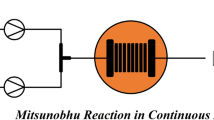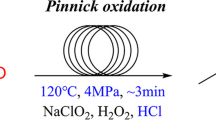Abstract
A flow synthesis method of (E)-2-hexenal intermediates by employing a two-stage microreactor system was reported as an example of autothermal Prins-type reaction. The continuous flow technology not only overcame the low efficiency of batch reactions, it also met the demand for high selectivity and required less consumption of reactants. Temperature monitors of a micro-mixer and a reaction tube covered by thick thermal insulation materials provided an apparent reaction enthalpy of −112 kJ·mol−1 for the generations of hexenal intermediates and by-products. A two-stage reaction platform was therefore developed to enable efficient control of the reaction temperature, which was from 20 °C and 110 °C. Under optimized operating conditions, the yield of (E)-2-hexenal intermediates reached 72%, with a space time yield of 273 kg·h−1 L−1, which was over 1200 times that of a traditional batch reactor with dripping fed reactants. The final yield of (E)-2-hexenal was maintained at 72% after hydrolysis of the intermediates.







Similar content being viewed by others
References
van Schie M, de Almeida TP, Laudadio G, Tieves F, Fernandez-Fueyo E, Noel T, Arends I, Hollmann F (2018) Biocatalytic synthesis of the green note trans-2-hexenal in a continuous-flow microreactor. Beilstein J Org Chem 14:697–703. https://doi.org/10.3762/bjoc.14.58
Mandal S, Mandal S, Ghosh SK, Ghosh A, Saha R, Banerjee S, Saha B (2016) Review of the aldol reaction. Synth Commun 46:1327–1342. https://doi.org/10.1080/00397911.2016.1206938
Ding KH, Xu L, Zhu YF, Wang YM, Wang GL, Liu BE, Sun W, Gu F (2018) A method of synthesizing (E)-2-hexenal. CN patent 108752177A, Nov 6, 2018
Jouffret M (1974) Process for the preparation of 2-hexenal. US patent 3839457, Oct 1,1974
Isagulyants VI, Khaimova T, Melikyan V, Pokrovskaya S (1968) Condensation of unsaturated compounds with formaldehyde (the Prins reaction). Russ Chem Rev 37(1):17–25. https://doi.org/10.1070/RC1968v037n01ABEH001604
Tadpetch K, Rychnovsky SD (2008) Rhenium (VII) catalysis of Prins cyclization reactions. Org Lett 10(21):4839. https://doi.org/10.1021/ol8019204
Liu L, Kaib PSJ, Tap A, List B (2016) A general catalytic asymmetric Prins cyclization. J Am Chem Soc 138(34):10822–10825. https://doi.org/10.1021/jacs.6b07240
Bach T, Lobel J (2002) Selective Prins reaction of styrenes and formaldehyde catalyzed by 2,6-di-tert-butylphenoxy(difluoro)borane. Synthesis 17:2521–2526. https://doi.org/10.1055/s-2002-35645
Liu GQ, Cui B, Xu R, Li YM (2016) Preparation of trans-2-substituted-4-halopiperidines and cis-2-substituted-4-halotetrahydropyrans via AlCl3-catalyzed Prins reaction. J Organomet Chem 81(12):5144–5161. https://doi.org/10.1021/acs.joc.6b00725
Chavre SN, Choo H, Lee JK, Pae AN, Kim Y, Cho YS (2008) 5- and 6-exocyclic products, cis-2,3,5-trisubstituted tetrahydrofurans, and cis-2,3,6-trisubstituted tetrahydropyrans via Prins-type cyclization. J Organomet Chem 73(19):7467–7471. https://doi.org/10.1021/jo800967p
Grammer GN (1958) The trimerization of aldehydes. LSU Historical Dissertations and Theses 462. https://digitalcommons.lsu.edu/gradschool_disstheses/462?utm_source=digitalcommons.lsu.edu%2Fgradschool_disstheses%2F462&utm_medium=PDF&utm_campaign=PDFCoverPages
Alexander ER, Marvell EN (1950) The trimer of isobutyraldehyde. J Am Chem Soc 72(3):1396–1396. https://doi.org/10.1021/ja01159a501
Hashimoto K, Sumitomo H, Kawase S (1977) Equilibrium cyclotrimerization of n-butyraldehyde. J Polym Sci: Polym Chem Edit 15(7):1609–1618. https://doi.org/10.1002/pol.1977.170150709
Higashimura T, Sawamoto M (1996) In: comprehensive polymer science and supplements, volume 3, 42 - Carbocationic polymerization: vinyl ethers, Elsevier ltd., UK, 1996, 673–696. https://doi.org/10.1016/B978-0-08-096701-1.00104-X
Rossetti I, Compagnoni M (2016) Chemical reaction engineering, process design and scale-up issues at the frontier of synthesis: flow chemistry. Chem Eng J 296:56–70. https://doi.org/10.1016/j.cej.2016.02.119
Jensen KF (2017) Flow chemistry - microreaction technology comes of age. AICHE J 63(3):858–869. https://doi.org/10.1002/aic.15642
Akwi FM, Watts P (2018) Continuous flow chemistry: where are we now? Recent applications, challenges and limitations. Chem Commun 54(99):13894–13928. https://doi.org/10.1039/c8cc07427e
Zhang J, Wang K, Teixeira AR, Jensen KF, Luo G (2017) Design and scaling up of microchemical systems: a review. Annu Rev Chem Biomol Eng 8(1):285–305. https://doi.org/10.1146/annurev-chembioeng-060816-101443
Plutschack MB, Pieber B, Gilmore K, Seeberger PH (2017) The Hitchhiker's guide to flow chemistry (II). Chem Rev 117(18):11796–11893. https://doi.org/10.1021/acs.chemrev.7b00183
Zuckerman NB, Shusteff M, Pagoria PF, Gash AE (2015) Microreactor flow synthesis of the secondary high explosive 2,6-diamino-3,5-dinitropyrazine-1-oxide (LLM-105). J Flow Chem 5(3):178–182. https://doi.org/10.1556/1846.2015.00016
Nagaki A, Takabayashi N, Tomida Y, Yoshida J (2008) Selective monolithiation of dibromobiaryls using microflow systems. Org Lett 10(18):3937–3940. https://doi.org/10.1021/ol8015572
Nagaki A, Kim H, Usutani H, Matsuo C, Yoshida J (2010) Generation and reaction of cyano-substituted aryllithium compounds using microreactors. Org Biomol Chem 8(5):1212–1217. https://doi.org/10.1039/b919325c
Nagaki A, Kim H, Yoshida J (2009) Nitro-substituted aryl lithium compounds in microreactor synthesis: switch between kinetic and thermodynamic control. Angew Chem Int Edit 48(43):8063–8065. https://doi.org/10.1002/anie.200904316
Guo SZ, Yu ZQ, Yu CM (2018) Kilogram-scale synthesis of 2,4-dichloro-5-fluorobenzoic acid by air oxidation under the continuous-flow process. Org Process Res Dev 22(2):252–256. https://doi.org/10.1021/acs.oprd.7b00358
Chen YZ, Zhao YC, Han M, Ye CB, Dang MH, Chen GW (2013) Safe, efficient and selective synthesis of dinitro herbicides via a multifunctional continuous-flow microreactor: one-step dinitration with nitric acid as agent. Green Chem 15(1):91–94. https://doi.org/10.1039/c2gc36652e
Adeyemi A, Bergman J, Branalt J, Savmarker J, Larhed M (2017) Continuous flow synthesis under high-temperature/high-pressure conditions using a resistively heated flow reactor. Org Process Res Dev 21(7):947–955. https://doi.org/10.1021/acs.oprd.7b00063
Gerardy R, Winter M, Vizza A, Monbaliu JM (2017) Assessing inter- and intramolecular continuous-flow strategies towards methylphenidate (Ritalin) hydrochloride. React Chem Eng 2:149–158. https://doi.org/10.1039/C6RE00184J
Kurt SK, Gelhausen MG, Kockmann N (2015) Axial dispersion and heat transfer in a milli/microstructured coiled flow inverter for narrow residence time distribution at laminar flow. Chem Eng Technol 38(7):1122–1130. https://doi.org/10.1002/ceat.201400515
Schwolow S, Mutsch B, Kockmann N, Röder T (2019) Model-based scale-up and reactor design for solvent-free synthesis of an ionic liquid in a millistructured flow reactor. React Chem Eng 4:523–536. https://doi.org/10.1039/C8RE00148K
Wang K, Lu YC, Shao HW, Luo GS (2010) Measuring enthalpy of fast exothermal reaction with micro-reactor-based capillary calorimeter. AICHE J 56(4):1045–1052. https://doi.org/10.1002/aic.11792
Wang K, Lu YC, Xia Y, Shao HW, Luo GS (2011) Kinetics research on fast exothermic reaction between cyclohexanecarboxylic acid and oleum in microreactor. Chem Eng J 169(1–3):290–298. https://doi.org/10.1016/j.cej.2011.02.072
Zheng C, Zhao BC, Wang K, Luo GS (2015) Determination of kinetics of CO2 absorption in solutions of 2-amino-2-methyl-1-propanol using a microfluidic technique. AICHE J 61(12):4358–4366. https://doi.org/10.1002/aic.14972
Liu GT, Wang K, Lu YC, Luo GS (2014) Liquid-liquid microflows and mass transfer performance in slit-like microchannels. Chem Eng J 258:34–42. https://doi.org/10.1016/j.cej.2014.07.035
Li LT, Zhang JS, Du CC, Luo GS (2018) Determination of the liquid/liquid mass transfer coefficient for each phase in microchannels. Ind Eng Chem Res 57(27):9028–9036. https://doi.org/10.1021/acs.iecr.8b01976
Acknowledgements
We gratefully acknowledge the support from National Natural Science Foundation of China (21991104).
Author information
Authors and Affiliations
Corresponding author
Ethics declarations
Conflict of interest
The authors declare that they have no conflict of interest.
Additional information
Publisher’s note
Springer Nature remains neutral with regard to jurisdictional claims in published maps and institutional affiliations.
Highlights
1. An autothermal Prins-type synthesis was realized for (E)-2-hexenal intermediates.
2. A two-stage microreactor system with high reaction yield of (E)-2-hexenal intermediates was developed.
3. Space time yield of (E)-2-hexenal intermediates was over 1000 times that of a traditional batch reactor.
Rights and permissions
About this article
Cite this article
Deng, J., Zou, P., Wang, K. et al. Continuous-flow synthesis of (E)-2-Hexenal intermediates using a two-stage microreactor system. J Flow Chem 10, 661–672 (2020). https://doi.org/10.1007/s41981-020-00112-7
Received:
Accepted:
Published:
Issue Date:
DOI: https://doi.org/10.1007/s41981-020-00112-7




